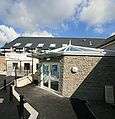Brynamman
Coordinates: 51°48′54″N 3°52′17″W / 51.81512°N 3.87136°W
Brynamman (Welsh: Brynaman) is a village sitting on the south facing side of the Black Mountain (Y Mynydd Du), part of the Brecon Beacons National Park (Parc Cenedlaethol Bannau Brycheiniog). The village is split in two into Upper Brynamman and Lower Brynamman by the River Amman which also acts as the boundary between the counties of Carmarthenshire and Neath Port Talbot (the old county of Glamorganshire). Ruins of stone dwellings (possibly prehistoric), an early type of lime kiln and rectangular medieval buildings found on the mountain show that man has lived in this area for a long time.
In the 18th century the industrial revolution, in the form of iron and tin works and especially coal mining, transformed the area from a small, scattered farming community to a built-up, highly populated commercial centre. The Welsh language was at the fore and the successful participation in local and national eisteddfodau by numerous village people, choirs and bands put Brynamman on the map.
It was once a thriving village, with three bank branches on Station Road in Upper Brynamman alone. Today there are no industries in or around the village, its inhabitants having to commute to Ammanford, Swansea or Llanelli for work. The whole area has become more attractive to live in especially for those who love the countryside and the wild open areas available for walking on the Black Mountain (Y Mynydd Du). It is still a stronghold for the Welsh language and children are taught it in school and it is spoken by a high majority of the local people.
Brynamman was previously known as Y Gwter Fawr (Welsh: "The Big Gutter"), the name was changed when the railway from Ammanford reached the village. The traveller and writer George Borrow describes aspects of Gwter Fawr in the mid-nineteenth century in his book Wild Wales which was published in 1862.
Brynamman Golf Club (now defunct) first appeared in the mid 1920s. It continued into the 1930s.[1]
Treftadaeth Brynaman Heritage
Treftadaeth Brynaman Heritage is a well-established local history group based in the library of Upper Brynaman Community Centre in the Upper Amman Communities First area. The group are very enthusiastic and have already undertaken a number of local history projects, the results of which are proudly displayed at the Community Centre. One member is currently co-ordinating a collection of photographs depicting Brynamman weddings and has gathered a wonderful array of photographs, invitations, bills and even a black wedding dress from 1890. The group has a membership of twenty-nine although only ten of these are very active within the group. For the Community Archives Wales project, the group are keen to research the changing nature of the shops and businesses in Brynamman, over the last century, and have a wide collection of photographs, billheads, letters and artefacts to digitise.
Bryn Rovers AFC
Bryn Rovers football club was founded in 1985 in Upper Brynamman by Doug Davies who had previously coached Gwaun Cae Gurwen's junior team. The majority of the players made their way up to Brynamman to form the new club.
Ynys Dawela
Situated adjacent to the west of Brynamman, Ynys Dawela Nature Park nestles in the upper reaches of the Amman Valley. Its northern boundary is the Brecon Beacons National Park with the rugged backdrop of the Black Mountain whilst the river Amman, with its fringe of ancient oak woodland, forms its southern boundary. The park covers an area of 39 acres (15.8 hectares) and was once a working farm. The meadows dating from this period now support a rich assortment of flowers, some of which are scarce, like the Whorled Caraway and Meadow Thistle. The meadows are at their most beautiful in late summer when most of the flowers are in bloom.
The park has a range of important habitats supporting a diverse assemblage of plant and animal life. The wet grasslands, marshy ground and ponds are particularly important to amphibians, like newts, frogs and toads whose numbers are in decline throughout the world.
The site narrowly escaped opencast mining, before Dinefwr Borough Council secured its future by purchasing it from British Coal. Since then the park has been developed for quiet recreation and educational use. Its patchwork of meadows woods and wetlands, linked by a series of paths are now open for all to enjoy. The park is managed by Carmarthenshire County Council supported by volunteers from the Friends of Ynys Dawela.
Gallery of photos
-

Black Mountain Centre in Brynamman
-

Brynamman Public Hall and Cinema
-

Former Brynamman GWR railway station in 1962
-

Former Brynamman LMS railway station in 1962
-

Gibea Chapel
Notable people
Notable current and former residents and natives include:
- Rees Howells (1879-1950) - intercessor, Congregationist minister, missionary to Southern Africa, Revivalist and founder of The Bible College of Wales - Swansea (1924)
- Roy Noble - broadcaster
- Dafydd Iwan - folk singer and politician
- Huw Ceredig - actor, brother of Dafydd Iwan (Reg Harries in Pobol Y Cwm and Fatty Lewis in Twin Town)
- Delme Bryn-Jones
Tregib Arms
The Tregib Arms is a public house in Brynamman built circa 1860.
The first ever union branch to look after the needs of Welsh anthracite miners was started in the public bar in 1891. [2] The original certificate can be viewed in the lounge bar.
During the 1930s Welsh Middleweight Boxing Champion Tommy Davies [3] was a regular customer, his photo can be seen in the main bar.
Notes
- ↑ “Brynamman Golf Club”, “Golf’s Missing Links”.
- ↑ The Society for the Protection of the Anthracite Miners Archived July 5, 2008 at the Wayback Machine
- ↑ "Tommy Davies". Britishboxing.net. Retrieved 2014-01-17.
External links
| Wikimedia Commons has media related to Brynamman. |
- Community Archives Wales
- Brynamman Public Hall
- Village History
- Black Mountain Centre / Community Centre for Brynamman
- Rees Howells
